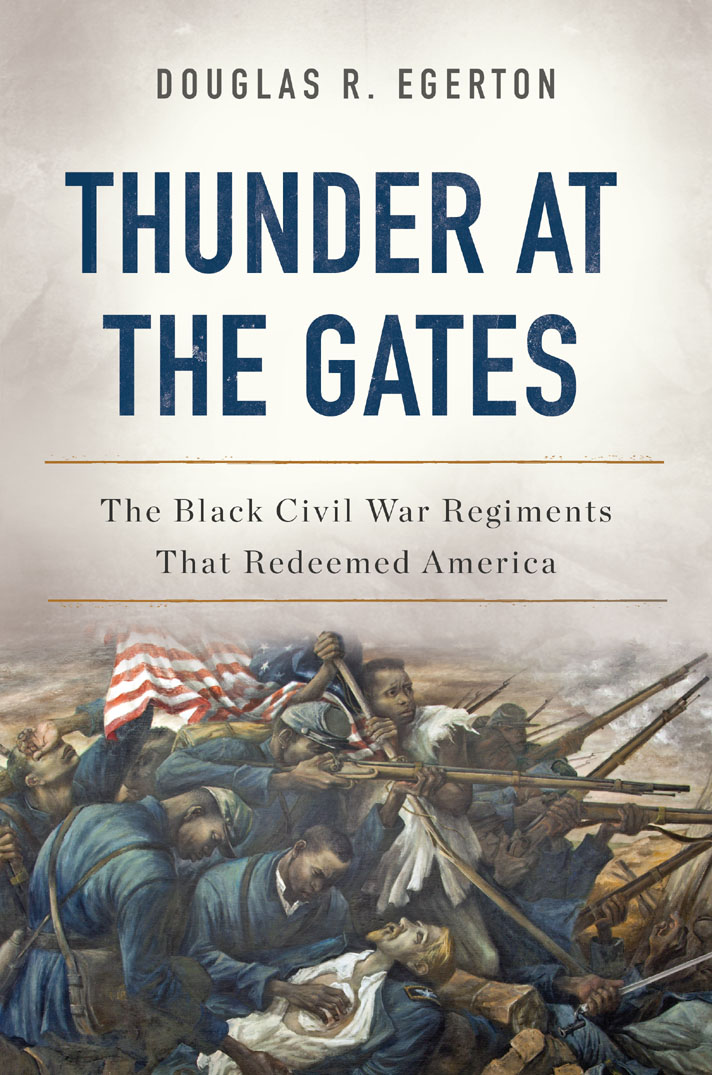
Thunder at the Gates
The Black Civil War Regiments That Redeemed America
کتاب های مرتبط
- اطلاعات
- نقد و بررسی
- دیدگاه کاربران
نقد و بررسی

September 12, 2016
In this solid addition to the Civil War literature, Egerton (The Wars of Reconstruction), professor of history at Le Moyne College, revisits the story of the 54th Massachusetts Volunteer Infantry Division, one of the state’s three African-American regiments, and expands on it in important ways. He pushes the standard narrative of the 54th beyond the 1863 battle at Fort Wagner to the bloody fight at Olustee, Fla., and into the postwar period. Providing a fuller picture of black men’s involvement in the war, Egerton weaves in the activities of the two other Massachusetts black regiments, the 55th Volunteer Infantry Division and the Fifth Cavalry. He emphasizes the ways race affected the men’s military experiences, looking as much at individual black soldiers as white officers. The first part of the book sets up the assault on Fort Wagner, providing a smooth account of the creation of the 54th and the recruitment of Robert Gould Shaw, its best-known white officer. The second part provides additional documentation of pervasive racism. Despite their demonstrated bravery at Fort Wagner, black troops endured
disproportionate assignment to “fatigue duty,” pay disparity, and unequal treatment under military law. Egerton’s fine work pays respect to the black soldiers who fought and died for black liberation. Illus. Agent: Daniel Greenberg, Levine Greenberg Rostan Literary.

The story of the black men, slaves and free, of the 54th and 55th Massachusetts Infantry, some of the greatest fighters of the Civil War.Egerton (History/Le Moyne Coll.; The Wars of Reconstruction: The Brief, Violent History of America's Most Progressive Era, 2014, etc.) understands that these men fought more for nationality and citizenship than to preserve the union. Their success in 1863 at Battery Wagner in Charleston, South Carolina, showed the world their mettle. Overcoming the racism just as inherent in the North as the South was an even bigger battle. After the Emancipation Proclamation took effect, Massachusetts Gov. John Andrew was permitted to form the first black regiment. Congress would not, however, allow black officers, doctors, or ministers. Consequently, Robert Gould Shaw and Ned and Pen Hallowell, Philadelphia Quakers, became the leaders of the 54th and the 55th regiments, and Charles Adams Jr. led the 5th Cavalry. Adams' regiment formed late in the war, and his leadership did not allow room for respect for his black men. Also included in the forces were two sons of Frederick Douglass: Lewis, whose wounds at Wagner ended his fighting days, and Charles, whose literacy led him to become the camp clerk. The Confederacy ruled that any blacks caught would be turned over to the state--no doubt to be reduced to slaves, no matter their background. The policy toward white leaders was that they were to be executed. The men saw how the Rebels treated blacks who tried to surrender; they were shot. After a battle, Rebel soldiers systematically walked among the wounded, executing any black soldiers. In this welcome addition to Civil War literature, Egerton gives readers a greater appreciation for their courage. A thoroughly researched, comprehensive look at the Civil War regiments who took the first step in the struggle to make their countrymen see them as intelligent, capable men. COPYRIGHT(1) Kirkus Reviews, ALL RIGHTS RESERVED.

Starred review from September 15, 2016
Egerton (Merrill Family Visiting Professor in History, Cornell Univ.; The Wars of Reconstruction) presents a captivating narrative of 14 men who served with the 54th and 55th Massachusetts infantry and the 5th Massachusetts cavalry. Four white officers commanded the regiments, all wealthy and well-educated men, including Robert Gould Shaw and Charles Francis Adams Jr. At the center of this volume's biographical portrait are African Americans from a variety of backgrounds who sought to end slavery: escaped slave William Carney, former schoolteachers Nicolas Said and James Trotter, and seamen Henry Jarvis and James Gooding. Egerton details the regiments' training and their participation in battles at Fort Wagner, SC, and their participation in the occupation of Charleston, SC, at the conclusion of the Civil War. The men proved their worth as disciplined soldiers and helped focus the nation's attention on freedom and equal rights for African Americans. VERDICT Egerton's study of the individuals and attention to their lives after the war is extremely well researched and well documented. This is an important addition to the shelves of Civil War books.--Patricia Ann Owens, formerly with Illinois Eastern Community Colls., Mt. Carmel
Copyright 2016 Library Journal, LLC Used with permission.

October 15, 2016
The 1989 film, Glory, brought long overdue attention to the contributions of African American regiments to Union victory in the Civil War. That mildly fictionalized film concentrated on the 54th Massachusetts infantry regiment and its white commander, Robert Gould Shaw. Egerton (Year of Meteors, 2010) has written a more factual, broader, and nuanced account of the service of black Civil War regiments. His account includes the formation and activities of Shaw's troops along with those of the 55th infantry, the 5th cavalry, and other units. Like Shaw's, those units were overseen by white officers, and some were not particularly enthusiastic about leading black soldiers. The feeling that blacks lacked the courage and discipline to fight was widespread. Egerton strongly emphasizes the racism black soldiers faced from within their own ranks, which made their bravery under fire even more inspiring. Of course, as Egerton reminds us, they were fighting for themselves and the freedom of other African Americans, not to preserve the Union. This is a brutally honest, comprehensive account of their contributions and an excellent addition to Civil War collections.(Reprinted with permission of Booklist, copyright 2016, American Library Association.)

























دیدگاه کاربران